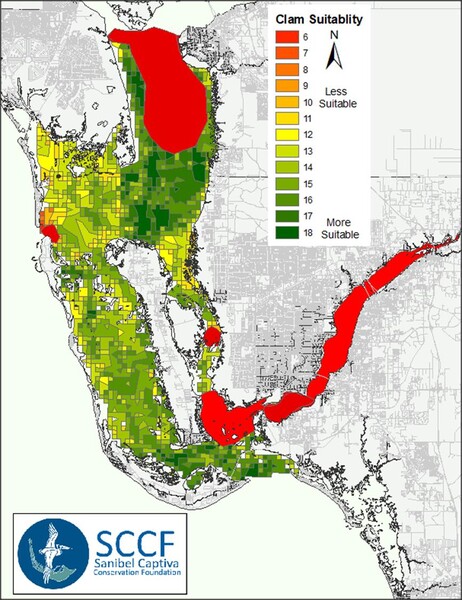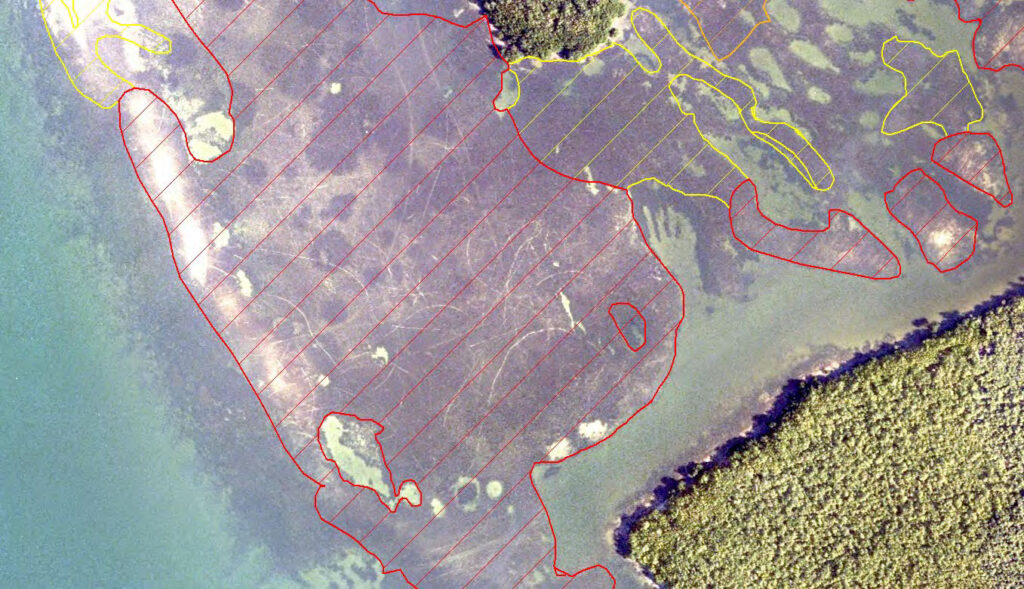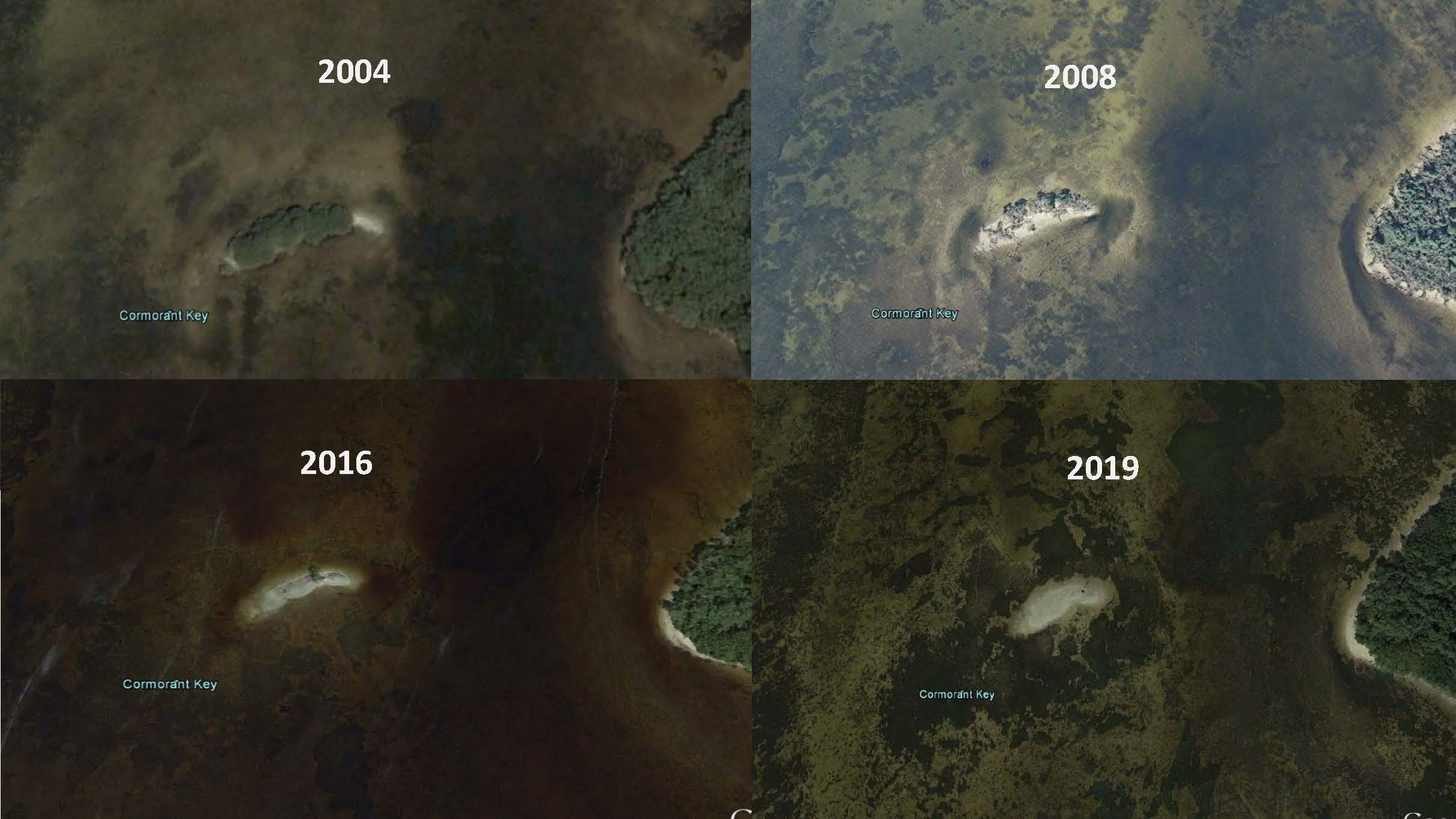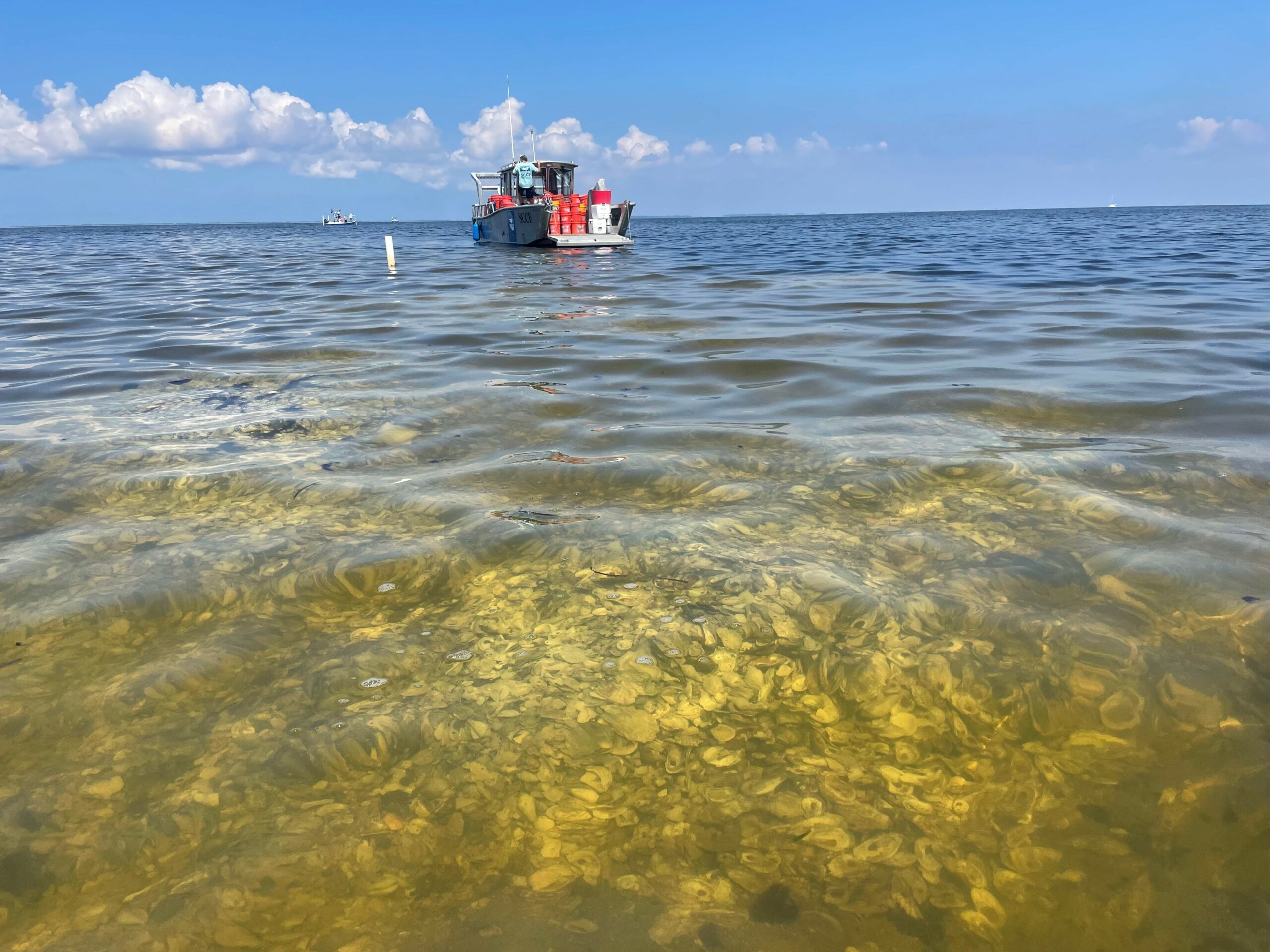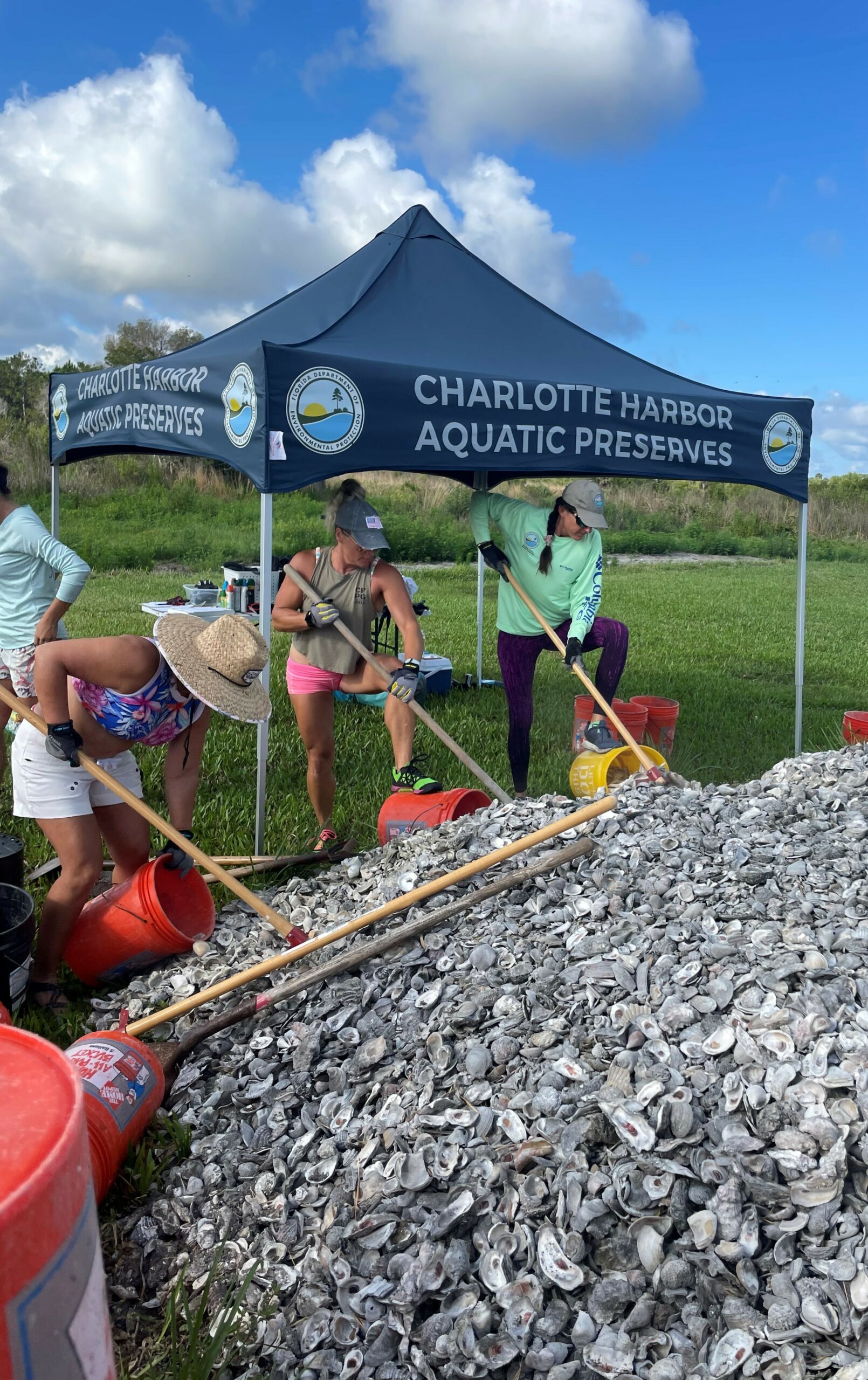| The Friends of Charlotte Harbor Aquatic Preserves are pleased to support many projects implemented by the Charlotte Harbor Aquatic Preserves and the Charlotte Harbor Preserve State Park. These projects have ranged from bat houses and removal of exotics on the land for the Preserve State Park and projects described below for the Aquatic Preserves. |
Projects Supported by FCHAP
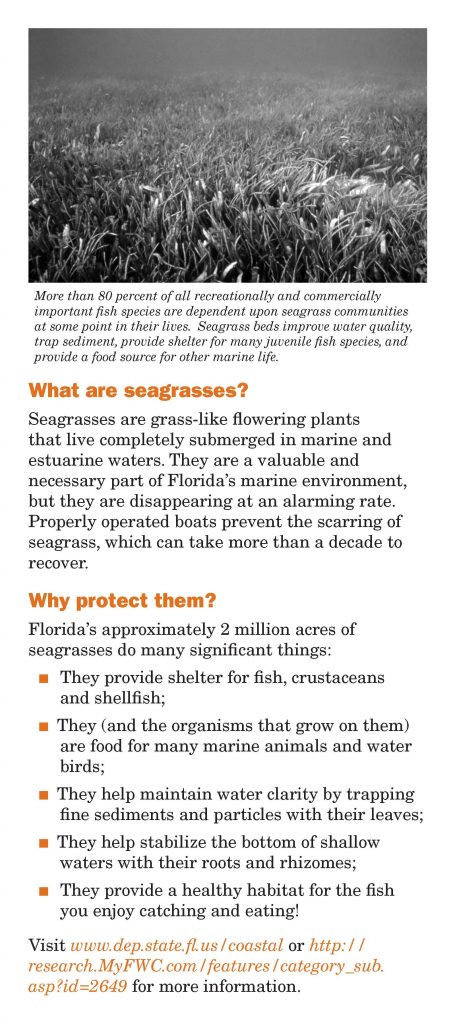
The estuaries that make up the Charlotte Harbor Aquatic Preserves are dynamic and ecologically complex. Seagrasses, mud flats and oyster bars lie beneath the shallow, inshore waters of these estuaries. These submerged resources provide numerous ecosystem functions within the estuaries of southwest Florida and are often used as the measure of overall estuarine health. In addition to being essential fish habitat, oyster reefs bio-assimilate nutrients, filter water, reduce turbidity and stabilize shorelines. Seagrass beds actively produce oxygen and store carbon as well as provide shelter for many commercially important marine species. They also maintain water clarity and stabilize habitat bottom where they grow. Degradation of these habitats can negatively affect water quality, the stability of surrounding habitats and the species that depend on them for food and habitat.
Impacts from boat propellers to these natural resources have become a concern both statewide and within the Charlotte Harbor Aquatic Preserves. Boat propellers can tear up seagrass beds, also known as prop scarring. It can take 5-10 years for a seagrass bed to recover from one prop scar incident. Boat wakes can erode the shoreline and disturb oyster reefs while boat props can drag along the bottom and dislodge oyster clumps. In addition to environmental costs, running aground can be costly for boaters. Increasing damage to seagrass beds from improper boating techniques led to the passing of legislation in 2009 making it illegal to cause destruction to seagrass beds in Florida aquatic preserves. Destruction of seagrass within an aquatic preserve can carry a penalty of up to $1,000. This is in addition to damage that may be inflicted to a boatʼs prop or lower unit during grounding events.
The public is encouraged to enjoy the aquatic preserves while employing proper boating techniques to help preserve the natural resources for future generations to enjoy. Prop scars can be reduced by operating your boat in appropriate water depths, using a navigation chart, depth finder and becoming familiar with the local waters and changing tides. Boat operators should watch for buoys which mark the edges of some seagrass beds, travel in marked channels, abide by manatee and other slow and idle zones and read the water. A seagrass bed often appears as a large dark shadow underwater relative to the surrounding areas. If you do run aground, turn off the engine, raise the motor and walk, or pole, your boat back out to deeper waters. Boat U.S offers a free boating safety course, approved by the Florida Fish and Wildlife Commission, and other boater resources are available.
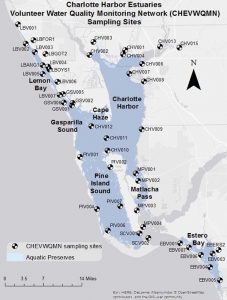
CHAP received funding to have their volunteer water quality monitoring program and continuous water quality monitoring program data analyzed for long-term status and trends.
The Charlotte Harbor Estuaries Volunteer Water Quality Monitoring Network, a program that began in 1996, is a coordinated system of volunteers who regularly conduct water quality monitoring throughout CHAP’s five aquatic preserves and Estero Bay aquatic preserve. CHAPs Continuous Water Quality Program has been conducting continuous water quality monitoring in Matlacha Pass since 2005. To date, their datasonde program activity samples water quality at three fixed sites within Matlacha Pass Aquatic Preserve and one site in Gasparilla Sound-Charlotte Harbor Aquatic Preserve collecting water readings every 15 minutes. Data collected through December 2022 has been included in the analysis for both programs. A report will be available in 2024.
FDEP Charlotte Harbor Aquatic Preserves received a National Fish and Wildlife Foundation Fishing for Energy grant in September 2019 to remove derelict fishing gear and other debris from four artificial reefs in the Charlotte Harbor Aquatic Preserves. A total of 4,262 lbs of debris was removed and turned into energy. Local partners helped make this project a success including the Lee County Volunteer Scientific Research Dive Team that assessed the reefs before and after removal; ScubaQuest provided dive gear; West Coast Inland Navigation District provided match and boat captain; Charlotte County assisted with assessments and removal efforts; Florida Marine Works and Fantasea Watersports sorted, catalogued and removed the debris; Covanta recycled the waste; Pelican Media produced the video. Funding was provided by the National Fish and Wildlife Foundationʼs Fishing for Energy Program, with support from NOAA Marine Debris Program, Covanta and Schnitzer Steel.
Learn more in the interactive story map.
The Fishing for Energy grant from the NFWF provides funding to the DEP protection so scuba divers from Florida Marine Works and others can retrieve debris found engulfed within four artificial reefs in the harbor.
Nearly 102,000 wading bird nests were initiated during the 2021 wading bird nesting season, according to the latest South Florida Wading Bird Report. This represented the second largest number of nests initiated by wading birds since scientists started surveying nesting throughout the Everglades in 1996. Scientists use wading birds to gauge the overall health of the Everglades.
“This latest reporting year shows the benefits of Everglades restoration efforts when climatic conditions are favorable and the exciting potential for all the ongoing environmental restoration projects that will be finished in the coming years,” said SFWMD Dr. Mark Cook, lead editor of the SFWMD Wading Bird Report. “We had above average rainfall and favorable timing during the reporting period. This shows that as we are restoring the hydrology of the Everglades, getting the water right will allow Mother Nature to take advantage of favorable conditions when they are presented. All species, including wading birds, are benefitting.”
The report shows that all four wading birds species studied by the SFWMD had nesting seasons that exceeded their 10-year averages. In particular, White Ibises initiated more than 2.5 times as many nests as they have typically averaged over the past decade. Wood Storks and Roseate Spoonbills also nearly doubled their 10-year averages for nests. Most importantly, the report shows that approximately 34 percent of all nests were found in coastal areas, a region where scientists have been trying to restore nesting habitat for years. This represents one of the best years for coastal bird nesting in recent decades and a continuing trend of improved coastal bird nesting. Five to 10 years ago, as little as 10 percent of all nests were found in these areas.
In the 1980s and 1990s, before the start of Everglades restoration began, nesting years would routinely see as few as 5,000 nests throughout South Florida regardless of climatic conditions. The Comprehensive Everglades Restoration Plan (CERP) uses wading birds as a key indicator to understand the impacts of restoration efforts.
Working together with our federal, state, and local partners, the District continues to accelerate key projects that are improving the quantity, quality, timing and distribution of water to the Greater Everglades ecosystem. Dr. Cook credited the restoration projects and operational actions taken by the SFWMD with helping wading bird nesting recover in recent years. The District appreciates the many partners who assisted in the creation of this year’s report, which relies on data from the District and partner agencies and organizations.
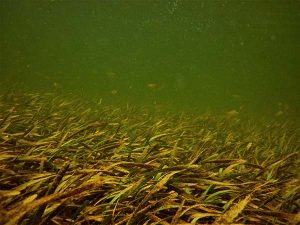
CHAP received funding to have their and Estero Bay Aquatic Preserve’s long-term seagrass dataset analyzed to examine changes and trends from 1998 through 2019. Janicki Environmental was contracted to complete the analysis, resulting in the report Identifying Potential Drivers of Change in Seagrass and Algal Community Composition in SWFL Aquatic Preserves. The analysis found that seagrass coverage overall appears to have gone back to the 2004/2005 baseline timeframe when there was lower abundance. Some areas, like Estero Bay and parts of Matlacha Pass, exhibited more recent seagrass decline. Increasing temperatures are a concern and high nitrate-nitrite concentrations are related to reduced seagrass abundance over time, suggesting there may be anthropogenic inputs.
Projects Supported by Others
While not supported by FCHAP, projects still further the management plan.

Seagrass is a submerged habitat that serves as an indicator of estuary health. Seagrasses provide primary food sources as well as shelter, spawning and nursery habitat to a great diversity of aquatic organisms. They also reduce turbidity, facilitate sediment stabilization and aid in nutrient cycling. Seagrass health depends on good water clarity and quality. Changes in water quality, hydrology and salinity directly affect seagrass distribution, abundance, and diversity.
Annual seagrass monitoring was established in 1999 at 50 transect sites throughout the Charlotte Harbor Aquatic Preserves to characterize conditions and record trends. Data is collected just after the growing season (August-October), starting from the shoreline to the deep edge of seagrass beds to determine species type, abundance, shoot density, blade lengths, maximum depth, and sediment type. With help from research partners and the use of aerial photography, the seagrass data is examined for changes over time and by aquatic preserve. The results are presented regularly at scientific conferences and have been published in Florida Scientist and Florida Fish and Wildlife Conservation Commissionʼs Seagrass Integrated Mapping and Monitoring reports.
Overall, seagrasses appear to be relatively healthy and stable throughout the CHAP, although there had been estuary-specific declines in some years that were associated with natural events like hurricanes and stronger than average rainy seasons. Healthy seagrass beds support fisheries and the local economy, as 80 percent of commercially and recreationally important fish and shellfish depend on seagrass habitat at one point in their life cycle.
Sanibel Captiva Conservation Foundation completed a hard clam restoration suitability modeling report. A habitat suitability model considers a habitat’s characteristics that make it a suitable environment for specific species. This project entailed analyzing water quality (salinity, temperature, dissolved oxygen, chlorophyll a), depth and presence of seagrass to model potential suitable locations to implement hard clam restoration within the Charlotte Harbor Aquatic Preserves. Specific sites were then chosen based on results from the model, historical information, and local clam farmer knowledge. Using the results of this project, partners will pursue funding for farmers (or others) to conduct restoration of hard clams in the most suitable locations throughout CHAP. Several partners assisted with this project, including the FWC restoration section and local aquaculture farmers.
For the 1st time since 2003 seagrass propeller scars, or prop scars, were mapped within all of CHAP. A project funded through public interest funds held by the Aquatic Preserve Society, 2018 aerial images for analyzed to determine if there are light, moderate or severe prop scarring within each area of the aquatic preserves. The seagrass prop scar mapping update is helpful for understanding the current status of damage across CHAP while also identifying specific areas of scarring severity.
In 2004, Hurricane Charley impacted Cormorant Key and many mangrove islands in Gasparilla Sound-Charlotte Harbor Aquatic Preserve. Cormorant Key was once a thriving mangrove island that has since became devoid of all mangroves due to erosion over the years and is now a sandy, shallow flat. This island is also a listed archaeological cultural site that is threatened by erosion.
In 2022, CHAP teamed up with Friends of CHAP, Sanibel-Captiva Conservation Foundation (SCCF) and 43 local volunteers from 11 organizations, for an oyster restoration project on Cormorant Key. On May 17-18, 2022, volunteers donated 168 hours to shovel, transport and help place more than 800 buckets of loose oyster shell (about 12 tons) on Cormorant Key.
The shell reef will serve as a substrate for oyster larvae to attach and grow, encouraging the formation of oyster reefs that provide important fish habitat and filtration for the estuary. The shell reef will also help trap and stabilize sediments that will aid in restoring the lost habitat and protect cultural resources that are present. SCCF and CHAP staff will monitor the project’s progress over time to evaluate oyster populations and the attraction of additional species to the area.
